How Gas Dryer Flame Sensor Works Repair Clinic
Gas dryers are fairly uncomplicated machines . With a basic understanding of how the parts of a gas dryer work and a fiddling DIY gas dryer repair coaching from yours truly, yous volition exist able to repair many gas dryer problems yourself. All tests should be performed with the dryer unplugged and all wires connected to the role being tested unplugged.
(Note: Label all terminals and connecting wires before disconnecting them for proper reinstallation.)
Igniter | Thermal Fuse | Hi-Limit Thermostat | Thermal Cut-Off | Cycling Thermostat | Thermostat Heater | Timer | Temperature Switch | Valve Solenoids (Coils) | Flame Switch | Burner | Thermistor | Moisture Sensor | Air Flow |Gas Supply | Dryer Won't Start | Dryer Noises | Electric Dryer Repair
Gas Dryer Repair – Possible causes
"Dryer won't heat" or "Dryer non hot plenty"
Gas Dryer Igniter:
Gas Dryer Repair Videos

The dryer igniter is responsible for igniting gas released from the burner valve. It receives electricity from the timer through a thermal fuse. For the DIY dryer repair person, if the dryer igniter is heating up it is not the crusade of a no estrus or low heat trouble. Also, if the dryer's igniter is not heating up, either the igniter is broken, or it may non be receiving electricity from the timer or control board through the dryer's thermal fuse to do its work. The dryer igniter rarely fails, but if replacement is demand for your dryer repair, be careful not to break the delicate new igniter or touch the office of the igniter that heats up. Oils from your skin can shorten the new igniter's life expectancy. And you will be putting on your dryer repair lid again soon.
Dryer Symptoms: The dryer won't heat.
Test: How-To Test A Dryer Igniter Video.
Unplug the igniter and check for resistance through the dryer igniter contacts. A small amount of resistance should be measured in the dryer igniter to create the rut required for dryer burner ignition. If the igniter tests okay and is not heating, check the dryer'south thermal fuse, flame switch, hi-limit thermostat, motor contacts, and timer, in that order.
Gas Dryer Thermal Fuse:
 The dryer's thermal fuse is a non-resettable safe fuse that is designed to break electrical contact to the dryer'south burner if the dryer becomes too hot. This fuse volition often burn out due to clogged dryer ducting or a defective cycling thermostat. The thermal fuse is the most common cause when a dryer has no heat.
The dryer's thermal fuse is a non-resettable safe fuse that is designed to break electrical contact to the dryer'south burner if the dryer becomes too hot. This fuse volition often burn out due to clogged dryer ducting or a defective cycling thermostat. The thermal fuse is the most common cause when a dryer has no heat.
Dryer Symptoms: On a gas dryer the dryer volition not start. However, in electric dryers, the dryer won't rut.
Test: How-To Exam A Dryer Fuse Videos.
Disconnect all connecting wires and check for continuity across the two wire contacts. In that location should be no resistance measured (a airtight circuit, allowing electricity to flow).
Gas Dryer Valve Solenoids(Coils):
Gas dryers use a set of solenoids (besides called safety coils) to open the dryer'south gas valve automatically after the flame switch has opened, indicating that the igniter is hot enough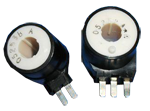 to ignite released gas. Every bit safety coils are going bad, they will work properly for a curt period. Then after a one-half an hour or and so of cycling on and off to maintain the drum's temperature, they will break down and end to open the valve, resulting in cool, moisture vesture at the stop of the cycle. Solenoids commonly need to exist replaced in a gas dryer.
to ignite released gas. Every bit safety coils are going bad, they will work properly for a curt period. Then after a one-half an hour or and so of cycling on and off to maintain the drum's temperature, they will break down and end to open the valve, resulting in cool, moisture vesture at the stop of the cycle. Solenoids commonly need to exist replaced in a gas dryer.
Dryer Symptoms:Dryer won't estrus at all or dryer will heat for a very short time and so the dryer won't estrus until it has been turned off for a time to allow the coils to cool down.
Test: If the igniter is getting hot and cycling off later on the flame switch opens, but no gas is released, the coils are probable the cause.
Gas Dryer Burner Valve:
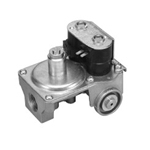 Gas dryers utilise a burner to generate the oestrus required to dry your apparel. These valves are extremely reliable and almost never need replacement. The valve is opened automatically by a set of solenoid coils. In some cases, allowing a propane tank to go dry tin can cause the valve to fail. However, all other possible causes should be checked before the dryer's valve is replaced. The safety coils are the nearly common crusade of a valve, non opening. Note: A valve yous intend to use again should not be opened for any reason considering this can cause dangerous gas leaks.
Gas dryers utilise a burner to generate the oestrus required to dry your apparel. These valves are extremely reliable and almost never need replacement. The valve is opened automatically by a set of solenoid coils. In some cases, allowing a propane tank to go dry tin can cause the valve to fail. However, all other possible causes should be checked before the dryer's valve is replaced. The safety coils are the nearly common crusade of a valve, non opening. Note: A valve yous intend to use again should not be opened for any reason considering this can cause dangerous gas leaks.
Dryer Symptoms:Dryer won't heat, or dryer is non hot enough.
Gas Dryer Flame Switch:
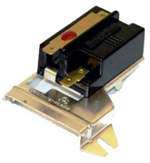 The flame switch (likewise chosen the window sensor) is used in gas dryers to guarantee that the igniter is hot plenty to ignite gas once information technology is released from the valve. When the flame switch is cool, it is airtight, assuasive electricity to energize the dryer's igniter. Only after it heats up, because of its proximity to the igniter, it opens routing power to the valve solenoids to open the valve and release gas. The flame switch rarely needs replacement.
The flame switch (likewise chosen the window sensor) is used in gas dryers to guarantee that the igniter is hot plenty to ignite gas once information technology is released from the valve. When the flame switch is cool, it is airtight, assuasive electricity to energize the dryer's igniter. Only after it heats up, because of its proximity to the igniter, it opens routing power to the valve solenoids to open the valve and release gas. The flame switch rarely needs replacement.
Test: To test the flame switch, back up the switch's terminals with a pair of needle nose pliers while y'all disconnect the 2 connecting wires. Check for continuity beyond the switches terminals. At that place should exist no resistance measured when the dryer is cool (a closed circuit, allowing electricity to catamenia.) If the igniter heats up but never clicks off, replace the dryer'south flame switch.
Dryer Symptoms:Dryer won't rut.
Gas Dyer How-do-you-do-Limit Thermostat:
The hullo-limit thermostat is a rubber switch that volition break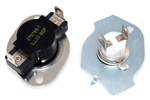 electrical contact to the dryer's burner or heater if information technology senses that the dryer has become too hot. The hi-limit thermostat will wheel the dryer'southward burner or heater off if the ducting has become clogged blocking proper airflow.
electrical contact to the dryer's burner or heater if information technology senses that the dryer has become too hot. The hi-limit thermostat will wheel the dryer'southward burner or heater off if the ducting has become clogged blocking proper airflow.
Dryer Symptoms: Ordinarily a very short heating period with a depression pulsate temperature or dryer won't heat at all. The hi-limit thermostat is a relatively reliable dryer component and is rarely the cause of dryer not heating problems.
Examination: Disconnect all connecting wires and cheque for continuity across the hi-limit thermostat or sensor set.
Thermal Cut-Off:
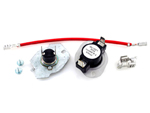 The dryer's thermal cut-off is like to the thermal fuse and the high limit thermostat. It volition interruption electrical contact to the dryer's burner or heating chemical element if it senses that the dryer is reaching an dangerous temperature. The thermal cut-off is a set of two thermostats, one of which will not reset once absurd. The thermal cut-off needs to be replaced as a set up. If this set up of dryer parts fails, you volition need to cheque your dryer and domicile ducting for clogging. And check to brand certain that the dryer's cycling thermostat is operating correctly. This type of safety thermostat does not but fail for no reason. If the not-resettable fuse has diddled out, you need to check and clean your home ducting!
The dryer's thermal cut-off is like to the thermal fuse and the high limit thermostat. It volition interruption electrical contact to the dryer's burner or heating chemical element if it senses that the dryer is reaching an dangerous temperature. The thermal cut-off is a set of two thermostats, one of which will not reset once absurd. The thermal cut-off needs to be replaced as a set up. If this set up of dryer parts fails, you volition need to cheque your dryer and domicile ducting for clogging. And check to brand certain that the dryer's cycling thermostat is operating correctly. This type of safety thermostat does not but fail for no reason. If the not-resettable fuse has diddled out, you need to check and clean your home ducting!
Dryer Symptoms:Dryer won't rut.
Test: Disconnect all connecting wires and check for continuity across the terminals. The thermal cut-off should be closed (allowing current to flow) at room temperature.
Gas Dryer Cycling Thermostat:
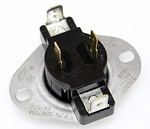 The cycling thermostat is responsible for cycling the dryer'south heat source on and off to keep a target temperature. The dryer'due south cycling thermostat is a very reliable bi-metal thermostat that rarely fails. This thermostat is usually closed, allowing electricity to menstruation freely. When the dryer heats up, it will open, breaking electrical contact to the dryer's rut source and allowing the drum temperature to driblet slightly, causing the thermostat to shut once more and reenergizing the dryer's rut source.
The cycling thermostat is responsible for cycling the dryer'south heat source on and off to keep a target temperature. The dryer'due south cycling thermostat is a very reliable bi-metal thermostat that rarely fails. This thermostat is usually closed, allowing electricity to menstruation freely. When the dryer heats up, it will open, breaking electrical contact to the dryer's rut source and allowing the drum temperature to driblet slightly, causing the thermostat to shut once more and reenergizing the dryer's rut source.
The thermostat's operating temperature range is identified on the office with an "Fifty" followed by the temperature. For example, L130 would open (cycling the dryer's heat off) at 130ºF. A nuance followed past another number, for case, L155-x, would hateful that the dryer thermostat would close after having cooled 10ºF. Faulty cycling thermostat symptoms could take the form of very high dryer temperatures, blown out thermal fuses, or no estrus. The cycling thermostat works with a thermostat heater to achieve lower dryer temperatures, such as low and medium heat settings.
Dryer Symptoms:Dryer won't oestrus, or dryer is too hot.
Test: Remove all connecting wires and test for continuity. There should be no resistance measured when the dryer is absurd (a closed circuit, assuasive electricity to menstruation). Cycling temperatures can be roughly calculated with a meat thermometer held next to the dryer's exhaust duct. As the dryer heat source is cycled on and off, temperatures tin be observed.
Gas Dryer Timer: 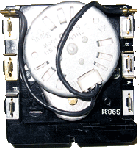
The dryer's timer routes electricity to the correct dryer components or system at the proper time. Timers are expensive, rarely fail, and are ofttimes misdiagnosed. The timer should be allowing electricity to flow to the dryer'due south burner and motor when needed.
Dryer Symptoms:Dryer won't heat, dryer won't turn on, or dryer won't turn off.
Test: Use your dryer's wiring diagram to check for voltage existence supplied to the heating circuit or motor excursion.
Gas Dryer Temperature Switch:
A clothes dryer's temperature selection switch is a simple switch that will send an electrical electric current to the thermostat heater through resistors. Resistors are usually located on the wires connecting to the switch, just sometimes within the switch itself depending on your model. In this way, the amount of current reaching the dryer'south thermostat heater is controlled. Some dryer models will utilize a thermistor and a separate solid-state control board to regulate the dryer's drum temperature. The dryer's temperature selection switch rarely fails.
Test: Disconnect all connecting wires and cheque for continuity across the switch and all wire harness resistors. If you take a solid-state control board, visually inspect it for burn marks. Use your dryer's wiring diagram for more authentic testing.
Remove all connecting wires and bank check for resistance across the two terminals of the heater. Some resistance should be detected allowing the heater to perform its work. If an open excursion is detected, the heater needs to be replaced. Also, check each of the heater'southward contacts to the outer containment unit of measurement of the heating chemical element. In that location should be no connection. If the heater tests okay, bank check the connected thermostats for continuity and your home'south power supply for full 240-volt supply.
Gas Dryer Thermistor:
A thermistor is a variable resistor that fluctuates the resistance information technology offers to a circuit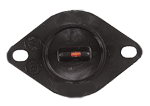 with temperature change. In this way, the thermistor tin can communicate with a solid-land control lath and give very accurate temperature readings. The symptoms of a faulty thermistor could be an fault code, incorrect dryer temperatures, or no heat. Thermistors accept very specific resistance requirements that are usually listed on a technical canvass located somewhere inside your dryer.
with temperature change. In this way, the thermistor tin can communicate with a solid-land control lath and give very accurate temperature readings. The symptoms of a faulty thermistor could be an fault code, incorrect dryer temperatures, or no heat. Thermistors accept very specific resistance requirements that are usually listed on a technical canvass located somewhere inside your dryer.
Dryer Symptoms:Dryer won't heat, or dryer is too hot.
Test: To test a thermistor, disconnect all connecting wires and perform a resistance check. The right resistance value must be identified for your model and can usually exist establish on your dryer's wiring diagram or technical guide, located somewhere within the dryer.
Gas Dryer Thermostat Heater: 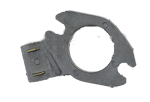
The thermostat heater is often located within the cycling thermostat. However, it may sometimes exist a dissever component mounted to the dryer'southward cycling thermostat. Depending on the dryer's temperature setting, more or less voltage is supplied to this heater. Low settings provide more voltage and create more rut, while medium settings supply slightly less voltage, generating less heat. Loftier heat settings will not energize the thermostat heater at all. Thus, the thermostat is tricked into thinking that the dryer is hotter than information technology is, and then information technology opens at a lower temperature. Problems with this organization can occur when the temperature selection switch fails to send the proper corporeality of voltage to the thermostat heater, or the heater itself fails to heat the thermostat.
Dryer Symptoms:Dryer won't heat, or dryer is besides hot.
Examination: Remove all connecting wires and check for resistance beyond the heater contacts. Approximately 3200-4000 ohms of resistance should be measured.
How Gas Dryer Flame Sensor Works Repair Clinic,
Source: https://applianceassistant.com/appliance-repair/dryer-repair/how-gas-dryer-parts-work/
Posted by: goldbergexpromen.blogspot.com


0 Response to "How Gas Dryer Flame Sensor Works Repair Clinic"
Post a Comment